Callovian-Oxfordian Ironstones at the Northwestern Margin of the Neo-Tethys Ocean, with Mineralogically Diverse Iron Ooids: Example from Kutch Basin, India
Abstract
1. Introduction
2. Geological Background
3. Samples and Methods
4. Results
4.1. Sedimentary Facies and Architecture
4.2. Petrography of Ooids
4.3. Mineralogy and Micro-Texture
4.4. Mineral Chemistry of Iron Ooids
5. Discussion
5.1. Depositional Environment
5.2. Genesis of Iron Ooids and Factors Controlling the Internal Variations
5.3. Callovian-Oxfordian Iron Ooids Across the Paleo-Tethys
6. Conclusions
- The limestone facies are primarily deposited as bioclastic and oolitic shoals associated with clastic lagoons. The repeated transition from shoal to lagoon reflects sea-level oscillations during the Callovian. The Oxfordian interval records a major transgression and condensation in Neo-Tethys, during which iron ooids and glauconitic smectite become abundant, near the maximum flooding surface, forming a condensed oolitic ironstone horizon. Iron ooids mainly form during transgression at a slow sedimentation rate.
- Iron ooids are composed of a mixture of iron silicates and iron oxide. Iron silicates like glauconitic smectite exhibit poorly-developed rosette micro-texture, while chamosite shows a flower-like micro-texture. The iron oxide goethite reflects a rod-like micro-texture. Based on the internal mineralogy and micro-textural distribution, ooids can be classified into three types (i) monomineralic, composed of either chamosite or goethite, (ii) quartz-nucleated, and (iii) composite ooids characterized by a chamosite core with either goethite or glauconitic smectite rim.
- The distinct compositional contrast between core and rim indicates their formation in different redox conditions. Glauconitic smectite develops in the suboxic settings, chamosite forms in the anoxic conditions, and goethite ooids precipitate under oxic conditions, within the different sub-environments of the bar-lagoon complex.
- The Jurassic ironstones formed in a marginal marine setting, which belonged to the Neo-Tethys Ocean. Intense continental weathering supplies elemental input in the shallow sea, facilitating ironstone formation in a warm, humid climate, which was further promoted by hydrothermal activity.
Supplementary Materials
Author Contributions
Funding
Data Availability Statement
Conflicts of Interest
Abbreviations
| XRD | X-Ray Diffraction |
| EPMA | Electron Probe Micro-Analyzer |
| SEM-EDS | Scanning Electron Microscopy-Energy Dispersive Spectroscopy |
References
- Van Houten, F.B.; Bhattacharyya, D.P. Phanerozoic Oolitic Ironstones- Geological Record and Facies Model. Annu. Rev. Earth Planet. Sci. 1982, 10, 441. [Google Scholar] [CrossRef]
- Young, T.P.; Taylor, W.E.G. Phanerozoic Ironstones; The Geological Society London: London, UK, 1989; ISBN 0903317435. [Google Scholar]
- Aurell, M.; Fernandez-Lopez, S.; Melendez, G. The Middle-Upper Jurassic oolitic Ironstone level in the Tererian Range (Spain) Eustatic Implications. Geobios 1994, 27, 549–561. [Google Scholar] [CrossRef]
- Taylor, K.G.; Macquaker, J.H.S. Spatial and Temporal Distribution of Authigenic Minerals in Continental Shelf Sediments: Implications for Sequence Stratigraphic Analysis. In Marine Authigenesis: From Global to Microbial; SEPM: Broken Arrow, OK, USA, 2000; Volume 66, pp. 309–323. [Google Scholar] [CrossRef]
- Mücke, A.; Farshad, F. Whole-Rock and Mineralogical Composition of Phanerozoic Ooidal Ironstones: Comparison and Differentiation of Types and Subtypes. Ore Geol. Rev. 2005, 26, 227–262. [Google Scholar] [CrossRef]
- Ramajo, J.; Aurell, M. Long-Term Callovian-Oxfordian Sea-Level Changes and Sedimentation in the Iberian Carbonate Platform (Jurassic, Spain): Possible Eustatic Implications. Basin Res. 2008, 20, 163–184. [Google Scholar] [CrossRef]
- Van Houten, F.B. Oolitic Ironstones and Contrasting Ordovician and Jurassic Paleogeography. Geology 1986, 13, 722–724. [Google Scholar] [CrossRef]
- McGregor, F.; Ramanaidou, E.; Wells, M. Phanerozoic Ooidal Ironstone Deposits—Generation of Potential Exploration Targets. Trans. Inst. Min. Metall. Sect. B Appl. Earth Sci. 2010, 119, 60–64. [Google Scholar] [CrossRef]
- Bekker, A.; Planavsky, N.J.; Krapež, B.; Rasmussen, B.; Hofmann, A.; Slack, J.F.; Rouxel, O.J.; Konhauser, K.O. Iron Formations: Their Origins and Implications for Ancient Seawater Chemistry. Treatise Geochem. Second Ed. 2014, 9, 561–628. [Google Scholar] [CrossRef]
- Young, T.P. Ooidal Ironstones from Ordovician Gondwana: A Review. Palaeogeogr. Palaeoclimatol. Palaeoecol. 1992, 99, 321–347. [Google Scholar] [CrossRef]
- Valdiya, K.S. The Making of India Geodynamic Evolution, 2nd ed.; Springer: Berlin/Heidelberg, Germany, 2016; ISBN 9783319250274. [Google Scholar]
- Van Houten, F.B.; Hou, H.F. Stratigraphic and Palaeogeographic Distribution of Palaeozoic Oolitic Ironstones. Geol. Soc. Mem. 1990, 12, 87–93. [Google Scholar] [CrossRef]
- Todd, S.E.; Pufahl, P.K.; Murphy, J.B.; Taylor, K.G. Sedimentology and Oceanography of Early Ordovician Ironstone, Bell Island, Newfoundland: Ferruginous Seawater and Upwelling in the Rheic Ocean. Sediment. Geol. 2019, 379, 1–15. [Google Scholar] [CrossRef]
- Muttoni, G.; Gaetani, M.; Kent, D.V.; Sciunnach, D.; Angiolini, L.; Berra, F.; Garzanti, E.; Mattei, M.; Zanchi, A. Opening of the Neo-Tethys Ocean and the Pangea B to Pangea A Transformation during the Permian. GeoArabia 2009, 14, 17–48. [Google Scholar] [CrossRef]
- Huggett, J.M. Minerals: Glauconites and Green Clays; Elsevier Inc.: Amsterdam, The Netherlands, 2013; ISBN 9780124095489. [Google Scholar]
- Megwara, J.U.; Aba’a, S.I.; Funtua, I.I. Mineralogical and Geochemical Studies of Ironstones around Koton Karfi, Part of Southern Bida Basin, North Central Nigeria. J. Emerg. Technol. Innov. Res. 2019, 6, 112–135. [Google Scholar]
- Odin, G.S.; Matter, A. De Glauconiarum Origine. Sedimentology 1981, 28, 121–151. [Google Scholar] [CrossRef]
- Van Houten, F.B.; Purucker, M.E. Glauconitic Peloids and Chamositic Ooids—Favorable Factors, Constraints, and Problems. Earth Sci. Rev. 1984, 20, 211–243. [Google Scholar] [CrossRef]
- Tang, D.; Shi, X.; Ma, J.; Jiang, G.; Zhou, X.; Shi, Q. Formation of Shallow-Water Glaucony in Weakly Oxygenated Precambrian Ocean: An Example from the Mesoproterozoic Tieling Formation in North China. Precambrian Res. 2017, 294, 214–229. [Google Scholar] [CrossRef]
- Tounekti, A.; Boukhalfa, K.; Choudhury, T.R.; Soussi, M.; Banerjee, S. Global and Local Factors behind the Authigenesis of Fe-Silicates (Glauconite/Chamosite) in Miocene Strata of Northern Tunisia. J. Afr. Earth Sci. 2021, 184, 104342. [Google Scholar] [CrossRef]
- Banerjee, S.; Bansal, U.; Vilas Thorat, A. A Review on Palaeogeographic Implications and Temporal Variation in Glaucony Composition. J. Palaeogeogr. 2016, 5, 43–71. [Google Scholar] [CrossRef]
- Baldermann, A.; Grathoff, G.H.; Nickel, C. Micromilieu-Controlled Glauconitization in Fecal Pellets at Oker (Central Germany). Clay Miner. 2012, 47, 513–538. [Google Scholar] [CrossRef]
- Baldermann, A.; Warr, L.N.; Grathoff, G.H.; Dietzel, M. The Rate and Mechanism of Deep-Sea Glauconite Formation at the Ivory Coast-Ghana Marginal Ridge. Clays Clay Miner. 2013, 61, 258–276. [Google Scholar] [CrossRef]
- Baldermann, A.; Warr, L.N.; Letofsky-Papst, I.; Mavromatis, V. Substantial Iron Sequestration during Green-Clay Authigenesis in Modern Deep-Sea Sediments. Nat. Geosci. 2015, 8, 885–889. [Google Scholar] [CrossRef]
- Baldermann, A.; Banerjee, S.; Czuppon, G.; Dietzel, M.; Farkaš, J.; Löhr, S.; Moser, U.; Scheiblhofer, E.; Wright, N.M.; Zack, T. Impact of Green Clay Authigenesis on Element Sequestration in Marine Settings. Nat. Commun. 2022, 13, 1527. [Google Scholar] [CrossRef] [PubMed]
- El Albani, A.; Meunier, A.; Fürsich, F. Unusual Occurrence of Glauconite in a Shallow Lagoonal Environment (Lower Cretaceous, Northern Aquitaine Basin, SW France). Terra Nov. 2005, 17, 537–544. [Google Scholar] [CrossRef]
- Huggett, J.; Adetunji, J.; Longstaffe, F.; Wray, D. Mineralogical and Geochemical Characterisation of Warm-Water, Shallow-Marine Glaucony from the Tertiary of the London Basin. Clay Miner. 2017, 52, 25–50. [Google Scholar] [CrossRef]
- Bayer, U. Stratigraphic and Environmental Patterns of Ironstone Deposits. Phaneroz. Ironstones Geol. Soc. Spec. Publ. 1989, 46, 105–117. [Google Scholar] [CrossRef]
- Chan, M.A. Oolitic Ironstone of The Cretaceous Western Interior Seaway, East-Cental Utah. J. Sediment. Res. 1992, 64, 693–705. [Google Scholar]
- Burkhalter, R.M. Ooidal Ironstones and Ferruginous Microbialites: Origin and Relation to Sequence Stratigraphy (Aalenian and Bajocian, Swiss Jura Mountains). Sedimentology 1995, 42, 57–74. [Google Scholar] [CrossRef]
- Macquaker, J.H.S.; Taylor, K.G.; Young, T.P.; Curtis, C.D. Sedimentological and Geochemical Controls on Ooidal Ironstone and “bone-Bed” Formation and Some Comments on Their Sequence-Stratigraphical Significance. Geol. Soc. Spec. Publ. 1996, 103, 97–107. [Google Scholar] [CrossRef]
- Collin, P.Y.; Loreau, J.P.; Courville, P. Depositional Environments and Iron Ooid Formation in Condensed Sections (Callovian-Oxfordian, South-Eastern Paris Basin, France). Sedimentology 2005, 52, 969–985. [Google Scholar] [CrossRef]
- Novoselov, K.A.; Belogub, E.V.; Kotlyarov, V.A.; Filippova, K.A.; Sadykov, S.A. Mineralogical and Geochemical Features of Oolitic Ironstones from the Sinara–Techa Deposit, Kurgan District, Russia. Geol. Ore Depos. 2018, 60, 265–276. [Google Scholar] [CrossRef]
- Rudmin, M.; Mazurov, A.; Banerjee, S. Origin of Ooidal Ironstones in Relation to Warming Events: Cretaceous-Eocene Bakchar Deposit, South-East Western Siberia. Mar. Pet. Geol. 2019, 100, 309–325. [Google Scholar] [CrossRef]
- Rudmin, M.; Banerjee, S.; Maximov, P.; Novoselov, A.; Trubin, Y.; Smirnov, P.; Abersteiner, A.; Tang, D.; Mazurov, A. Origin of Ooids, Peloids and Micro-Oncoids of Marine Ironstone Deposits in Western Siberia (Russia). J. Asian Earth Sci. 2022, 237, 105361. [Google Scholar] [CrossRef]
- Clement, A.M.; Tackett, L.S.; Ritterbush, K.A.; Ibarra, Y. Formation and Stratigraphic Facies Distribution of Early Jurassic Iron Oolite Deposits from West Central Nevada, USA. Sediment. Geol. 2020, 395, 105537. [Google Scholar] [CrossRef]
- Chen, S.; Zeng, M.; Tian, J.; Ren, K.; Wang, B.; Zhao, Z.; Chen, X.; Ettensohn, F.R.; Adatte, T. Microbe-Mediated, Marine Authigenic Formation of Ooidal Chamosite: Insights from Upper Ordovician Carbonates of the South-Western Yangtze Platform (China). Sedimentology 2023, 70, 1655–1678. [Google Scholar] [CrossRef]
- Luan, X.; Sproat, C.D.; Jin, J.; Zhan, R. Depositional Environments, Hematite–Chamosite Differentiation and Origins of Middle Ordovician Iron Ooids in the Upper Yangtze Region, South China. Sedimentology 2024, 71, 2210–2247. [Google Scholar] [CrossRef]
- Rudmin, M.; Banerjee, S.; Abdullayev, E.; Ruban, A.; Filimonenko, E.; Lyapina, E.; Kashapov, R.; Mazurov, A. Ooidal Ironstones in the Meso-Cenozoic Sequences in Western Siberia: Assessment of Formation Processes and Relationship with Regional and Global Earth Processes. J. Palaeogeogr. 2020, 9, 1. [Google Scholar] [CrossRef]
- Belasy, A.E.; Grammer, G.M.; Wanas, H.A.; Anan, T. Facies Architecture and sequence stratigraphy of the Coniacian-Santonian Mixed Siliciclastic Carbonate Matulla Formation, West Central Sinal, Egypt. Geol. Soc. Am. Abstr. Programs 2015, 47, 54. [Google Scholar]
- Saboor, A.; Wang, C.; Li, Y.; Reolid, M.; Jafarian, A.; Xi, C.; Wang, L.; Wang, M. Sedimentology, Geochemistry and Palaeoenvironments of Jurassic Oolitic Ironstones from the Eastern Tethys (Indus Basin, Northwestern Himalayas, Pakistan). Facies 2025, 71, 5. [Google Scholar] [CrossRef]
- Fürsich, F.T.; Oschmann, W.; Jaitly, A.K.; Singh, I.B. Faunal Response to Transgressive-Regressive Cycles: Example from the Jurassic of Western India. Palaeogeogr. Palaeoclimatol. Palaeoecol. 1991, 85, 149–159. [Google Scholar] [CrossRef]
- Fürsich, F.T.; Oschmann, W.; Singh, I.B.; Jaitly, A.K. Hardgrounds, Reworked Concretion Levels and Condensed Horizons in the Jurassic of Western India: Their Significance for Basin Analysis. J.-Geol. Soc. 1992, 149, 313–331. [Google Scholar] [CrossRef]
- Alberti, M.; Fürsich, F.T.; Pandey, D.K. Deciphering Condensed Sequences: A Case Study from the Oxfordian (Upper Jurassic) Dhosa Oolite Member of the Kachchh Basin, Western India. Sedimentology 2013, 60, 574–598. [Google Scholar] [CrossRef]
- Alberti, M.; Fürsich, F.T.; Pandey, D.K.; Ramkumar, M. Stable Isotope Analyses of Belemnites from the Kachchh Basin, Western India: Paleoclimatic Implications for the Middle to Late Jurassic Transition. Facies 2012, 58, 261–278. [Google Scholar] [CrossRef]
- Bansal, U.; Banerjee, S.; Chauhan, G.; Rudmin, M.; Borgohain, D.; Upadhyay, A. Geochemistry of Callovian Ironstone in Kutch and Its Stratigraphic Implications. In Mesozoic Stratigraphy of India; Springer International Publishing: Cham, Switzerland, 2021; pp. 215–239. ISBN 9783030713706. [Google Scholar]
- Fürsich, F.T.; Callomon, J.H.; Pandey, D.K.; Jaitly, A.K. Environments and Faunal Patterns in the Kachchh Rift Basin, Western India, during the Jurassic. Riv. Ital. Paleontol. Stratigr. 2004, 110, 181–190. [Google Scholar]
- Biswas, S.K.; Mahender, K.; Chauhan, G.D. Field Guide Book of Geology of Kutch (Kachchh) Basin, Gujarat, India; Springer: Berlin/Heidelberg, Germany, 2021; ISBN 9783030874698. [Google Scholar]
- Biswas, S.K. Regional Tectonic Framework, Structure and Evolution of the Western Marginal Basins of India. Tectonophysics 1987, 135, 307–327. [Google Scholar] [CrossRef]
- Krishna, J. An Overview of the Mesozoic Stratigraphy of Kachchh and Jaisalmer Basins. J. Palaeontol. Soc. India 1987, 32, 136–149. [Google Scholar] [CrossRef]
- Nerlich, R.; Colli, L.; Ghelichkhan, S.; Schuberth, B.; Bunge, H.P. Constraining Central Neo-Tethys Ocean Reconstructions with Mantle Convection Models. Geophys. Res. Lett. 2016, 43, 9595–9603. [Google Scholar] [CrossRef]
- Krishna, J. The Indian Mesozoic Chronicle; Springer: Singapore, 2017; Volume 10, ISBN 9789811024764. [Google Scholar]
- Talib, A.; Gaur, K.N.; Bhalla, S.N. Callovian-Oxfordian Boundary in Kutch Mainland, India—A Foraminiferal Approach. Rev. Paleobiol. 2007, 26, 625–630. [Google Scholar]
- Talib, A.; Jain, S.; Irshad, R. Integrated Benthic Foraminiferal and Ammonite Biostratigraphy of Middle to Late Jurassic Sediments of Keera Dome, Kachchh, Western India; Scientific Publishers: Jodhpur, India, 2017; pp. 71–81. [Google Scholar]
- Moore, D.M.; Reynolds, R.C., Jr. X-Ray Diffraction and the Identification and Analysis of Clay Minerals; Oxford University Press: Oxford, UK, 1989. [Google Scholar]
- Singh, P.; Banerjee, S.; Wagh, D.; Pande, K.; Bhattacharya, S. Origin of K-Rich Green Clays within Late Cretaceous Deccan Basalts: A Local K-Depository. Appl. Clay Sci. 2024, 250, 107270. [Google Scholar] [CrossRef]
- Roy Choudhury, T.; Banerjee, S.; Khanolkar, S.; Saraswati, P.K.; Meena, S.S. Glauconite Authigenesis during the Onset of the Paleocene-Eocene Thermal Maximum: A Case Study from the Khuiala Formation in Jaisalmer Basin, India. Palaeogeogr. Palaeoclimatol. Palaeoecol. 2021, 571, 110388. [Google Scholar] [CrossRef]
- Mandal, S.; Roy Choudhury, T.; Das, A.; Sarkar, S.; Banerjee, S. Shallow Marine Glauconitization during the Proterozoic in Response to Intrabasinal Tectonics: A Study from the Proterozoic Lower Bhander Sandstone, Central India. Precambrian Res. 2022, 372, 106596. [Google Scholar] [CrossRef]
- Banerjee, S.; Mondal, S.; Chakraborty, P.P.; Meena, S.S. Distinctive Compositional Characteristics and Evolutionary Trend of Precambrian Glaucony: Example from Bhalukona Formation, Chhattisgarh Basin, India. Precambrian Res. 2015, 271, 33–48. [Google Scholar] [CrossRef]
- Banerjee, S.; Farouk, S.; Nagm, E.; Choudhury, T.R.; Meena, S.S. High Mg-Glauconite in the Campanian Duwi Formation of Abu Tartur Plateau, Egypt and Its Implications. J. Afr. Earth Sci. 2019, 156, 12–25. [Google Scholar] [CrossRef]
- Singh, P.; Banerjee, S.; Choudhury, T.R.; Bhattacharya, S.; Pande, K. Distinguishing Celadonite from Glauconite for Environmental Interpretations: A Review. J. Palaeogeogr. 2023, 12, 179–194. [Google Scholar] [CrossRef]
- Amorosi, A.; Sammartino, I.; Tateo, F. Evolution Patterns of Glaucony Maturity: A Mineralogical and Geochemical Approach. Deep. Res. Part II Top. Stud. Oceanogr. 2007, 54, 1364–1374. [Google Scholar] [CrossRef]
- Thompson, G.R.; Hower, J. The Mineralogy of Glauconite. Clays Clay Miner. 1975, 23, 289–300. [Google Scholar] [CrossRef]
- López-Quirós, A.; Sánchez-Navas, A.; Nieto, F.; Escutia, C. New insights into the nature of glauconite. Am. Mineral. 2020, 105, 674–686. [Google Scholar] [CrossRef]
- Sanità, E.; Di Rosa, M.; Lardeaux, J.M.; Marroni, M.; Tamponi, M.; Lezzerini, M.; Pandolfi, L. Deciphering the Pressure—temperature Path in Low-Grade Metamorphic Rocks by Combining Crystal Chemistry, Thermobarometry and Thermodynamic Modelling: An Example in the Marguareis Massif, Western Ligurian Alps, Italy. Mineral. Mag. 2024, 89, 203–224. [Google Scholar] [CrossRef]
- Sanità, E.; Di Rosa, M.; Lardeaux, J.M.; Marroni, M.; Pandolfi, L. The Moglio-Testico Unit (Ligurian Alps, Italy) as Subducted Metamorphic Oceanic Fragment: Stratigraphic, Structural and Metamorphic Constraints. Minerals 2022, 12, 1343. [Google Scholar] [CrossRef]
- Fürsich, F.T.; Oschma; Pandey, D.K.; Jaitly, A.K.; Singh, I.B.; Liu, C. Paleoecology of the Middle to Lower Upper Jurassic Macofaunas of the Kachchh Basin Western India. J. Palaeontol. Soc. India 2004, 49, 1–26. [Google Scholar] [CrossRef]
- Kimberley, M.M. Origin of the oolitic Iron Formation. J. Sediment. Res. 1979, 49, 111–131. [Google Scholar]
- Van Houten, F.B. Review of Cenozoic Ooidal Ironstones. Sediment. Geol. 1992, 78, 101–110. [Google Scholar] [CrossRef]
- Hallam, A.; Maynard, J.B. The Iron Ores and Associated Sediments of the Chichali Formation (Oxfordian to Valanginian) of the Trans-Indus Salt Range, Pakistan. J. Geol. Soc. Lond. 1987, 144, 107–114. [Google Scholar] [CrossRef]
- Talbot, M.R. Ironstones in the Upper Oxfordian of Southern England. Sedimentology 1974, 21, 433–450. [Google Scholar] [CrossRef]
- Porrenga, D.H. Glauconite and Chamosite as Depth Indicators in the Marine Environment. Mar. Geol. 1967, 5, 495–501. [Google Scholar] [CrossRef]
- Porrenga, D.H. Non-Marine Glauconitic Illite in the Lower Oligocene of Aardebrug, Belgium. Clay Miner. 1968, 7, 421–430. [Google Scholar] [CrossRef]
- Bansal, U.; Pande, K.; Banerjee, S.; Nagendra, R.; Jagadeesan, K.C. The Timing of Oceanic Anoxic Events in the Cretaceous Succession of Cauvery Basin: Constraints from 40 Ar/39 Ar Ages of Glauconite in the Karai Shale Formation. Geol. J. 2019, 54, 308–315. [Google Scholar] [CrossRef]
- López-Quirós, A.; Escutia, C.; Sánchez-Navas, A.; Nieto, F.; Garcia-Casco, A.; Martín-Algarra, A.; Evangelinos, D.; Salabarnada, A. Glaucony Authigenesis, Maturity and Alteration in the Weddell Sea: An Indicator of Paleoenvironmental Conditions before the Onset of Antarctic Glaciation. Sci. Rep. 2019, 9, 13580. [Google Scholar] [CrossRef] [PubMed]
- Tribovillard, N.; Bout-Roumazeilles, V.; Delattre, M.; Ventalon, S.; Abraham, R.; Nzié, O. Syndepositional Glauconite as a Paleoenvironmental Proxy—The Lower Cenomanian Chalk of Cap Blanc Nez (N-France). Chem. Geol. 2021, 584, 120508. [Google Scholar] [CrossRef]
- Tribovillard, N.; Bout-Roumazeilles, V.; Abraham, R.; Ventalon, S.; Delattre, M.; Baudin, F. The Contrasting Origins of Glauconite in the Shallow Marine Environment Highlight This Mineral as a Marker of Paleoenvironmental Conditions. Comptes Rendus-Geosci. 2023, 355, 213–228. [Google Scholar] [CrossRef]
- Tang, D.; Shi, X.; Jiang, G.; Zhou, X.; Shi, Q. Ferruginous Seawater Facilitates the Transformation of Glauconite to Chamosite: An Example from the Mesoproterozoic Xiamaling Formation of North China. Am. Mineral. 2017, 102, 2317–2332. [Google Scholar] [CrossRef]
- Berner, R.A. A New Geochemical Classification Of Sedimentary Environments. J. Sediment. Res. 1981, 51, 359–365. [Google Scholar] [CrossRef]
- Kalinina, N.A.; Rudmin, M.A.; Sherstyukov, M.; Maximov, P.; Kerimov, A.G. Origin of Iron-Rich Minerals, Ooids and Pisoids in the Jurassic Ooidal Ironstones of the Labino-Malkin Region (Caucasus). J. Palaeogeogr. 2024, 13, 475–494. [Google Scholar] [CrossRef]
- Banerjee, S.; Chattoraj, S.L.; Saraswati, P.K.; Dasgupta, S.; Sarkar, U. Substrate Control on Formation and Maturation of Glauconites in the Middle Eocene Harudi Formation, Western Kutch, India. Mar. Pet. Geol. 2012, 30, 144–160. [Google Scholar] [CrossRef]
- Banerjee, S.; Bansal, U.; Pande, K.; Meena, S.S. Compositional Variability of Glauconites within the Upper Cretaceous Karai Shale Formation, Cauvery Basin, India: Implications for Evaluation of Stratigraphic Condensation. Sediment. Geol. 2016, 331, 12–29. [Google Scholar] [CrossRef]
- Baldermann, A.; Dietzel, M.; Mavromatis, V.; Mittermayr, F.; Warr, L.N.; Wemmer, K. The Role of Fe on the Formation and Diagenesis of Interstratified Glauconite-Smectite and Illite-Smectite: A Case Study of Lower Cretaceous Shallow-Water Carbonates. Chem. Geol. 2017, 453, 21–34. [Google Scholar] [CrossRef]
- Wright, J.; Schrader, H.; Holser, W.T. Paleoredox Variations in Ancient Oceans Recorded by Rare Earth Elements in Fossil Apatite. Geochim. Cosmochim. Acta 1987, 51, 631–644. [Google Scholar] [CrossRef]
- Powell, J.H.; Riding, J.B. Stratigraphy, Sedimentology and Structure of the Jurassic (Callovian to Lower Oxfordian) Succession at Castle Hill, Scarborough, North Yorkshire, UK. Proc. Yorksh. Geol. Soc. 2016, 61, 109–133. [Google Scholar] [CrossRef]
- Meléndez, G.; Ramajo, J.; Bello, J.; Page, K.N. Callovian and the Callovian—Oxfordian Transition Sedimentary Record in NE Iberian Chain: Taphonomic Analysis and Palaeogeography. J. Iber. Geol. 2007, 33, 261–282. [Google Scholar]
- Jadoul, F.; Berra, F.; Garzanti, E. The Tethys Himalayan Passive Margin from Late Triassic to Early Cretaceous (South Tibet). J. Asian Earth Sci. 1998, 16, 173–194. [Google Scholar] [CrossRef]
- Han, K.; Han, Z.; Garzanti, E.; Zhu, S.; Yao, H.; Guo, H.; Liu, X.; Wang, C. Middle Jurassic Ooidal Ironstones (Southern Tibet): Formation Processes and Implications for the Paleoceanography of Eastern Neo-Tethys. Front. Earth Sci. 2023, 10, 1055957. [Google Scholar] [CrossRef]
- Dera, G.; Pellenard, P.; Neige, P.; Deconinck, J.F.; Pucéat, E.; Dommergues, J.L. Distribution of Clay Minerals in Early Jurassic Peritethyan Seas: Palaeoclimatic Significance Inferred from Multiproxy Comparisons. Palaeogeogr. Palaeoclimatol. Palaeoecol. 2009, 271, 39–51. [Google Scholar] [CrossRef]
- Dera, G.; Brigaud, B.; Monna, F.; Laffont, R.; Pucéat, E.; Deconinck, J.F.; Pellenard, P.; Joachimski, M.M.; Durlet, C. Climatic Ups and Downs in a Disturbed Jurassic World. Geology 2011, 39, 215–218. [Google Scholar] [CrossRef]

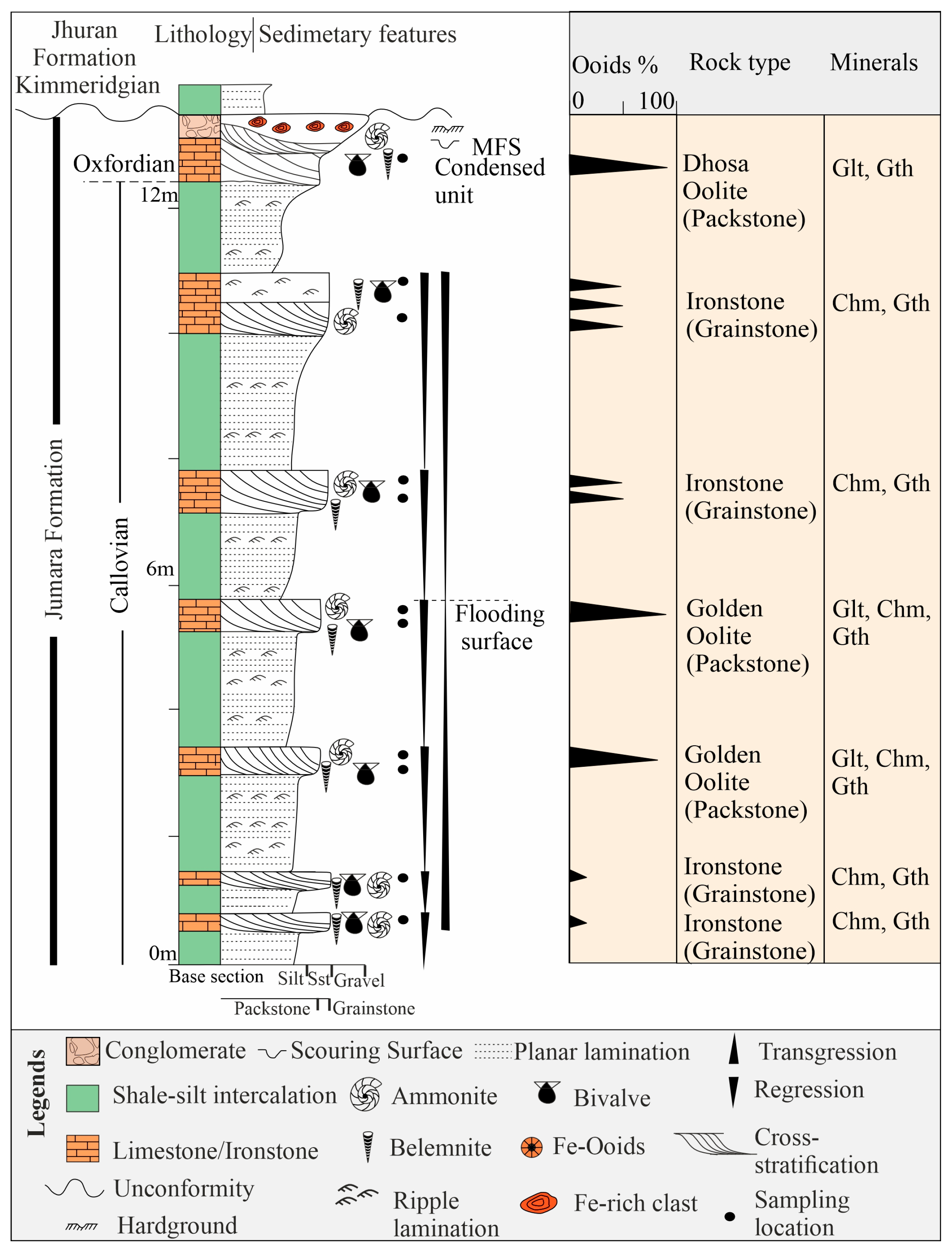
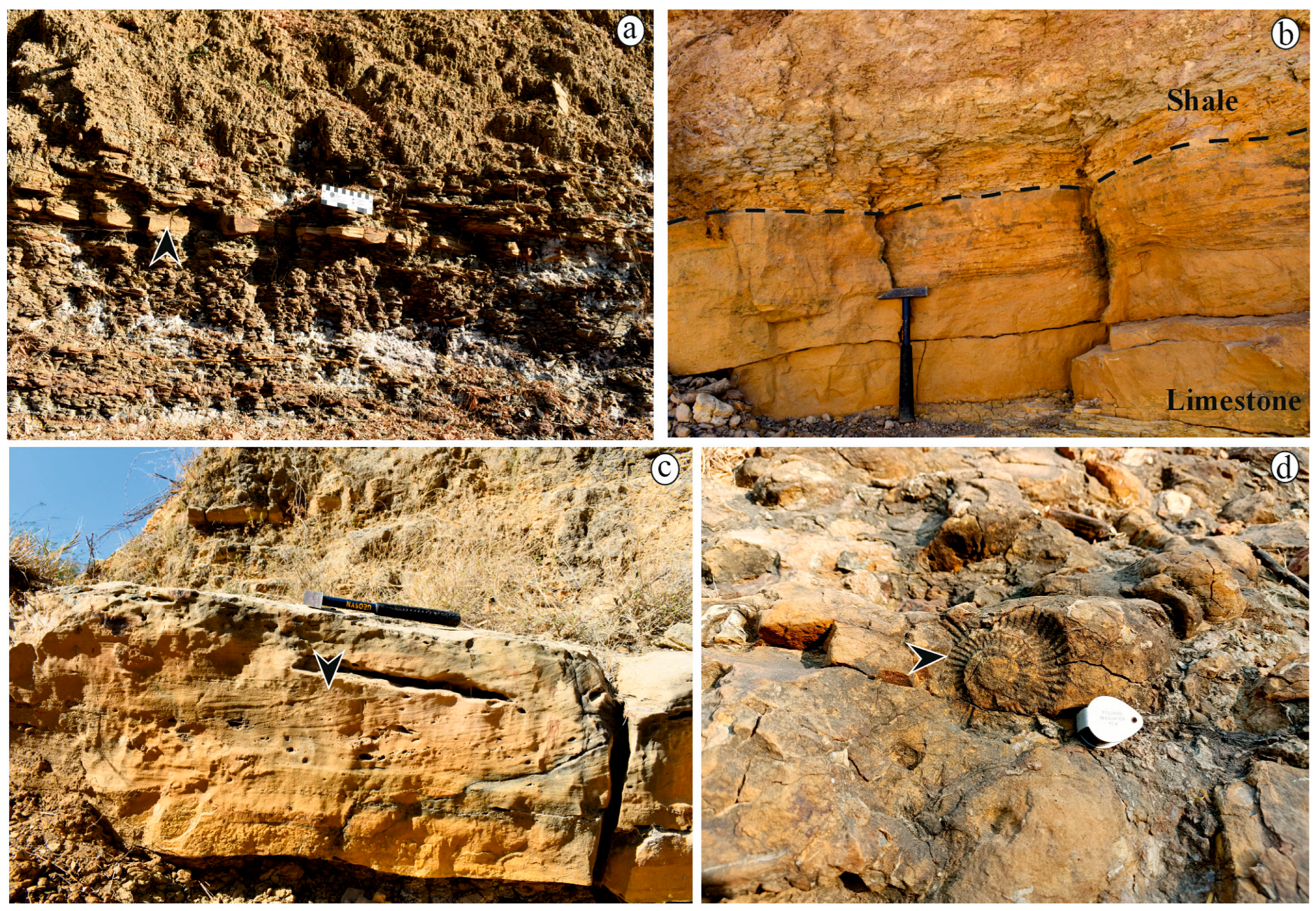

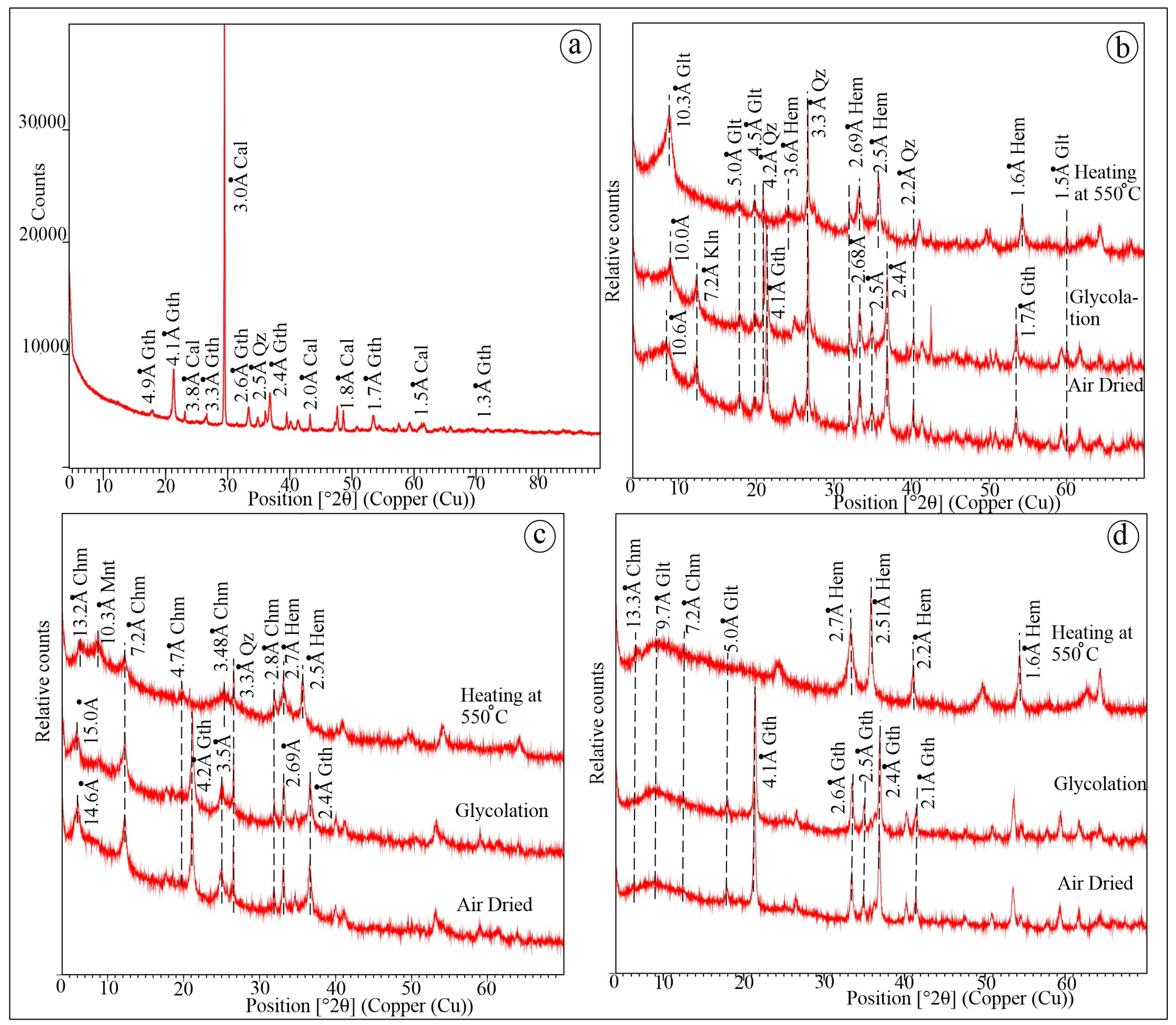


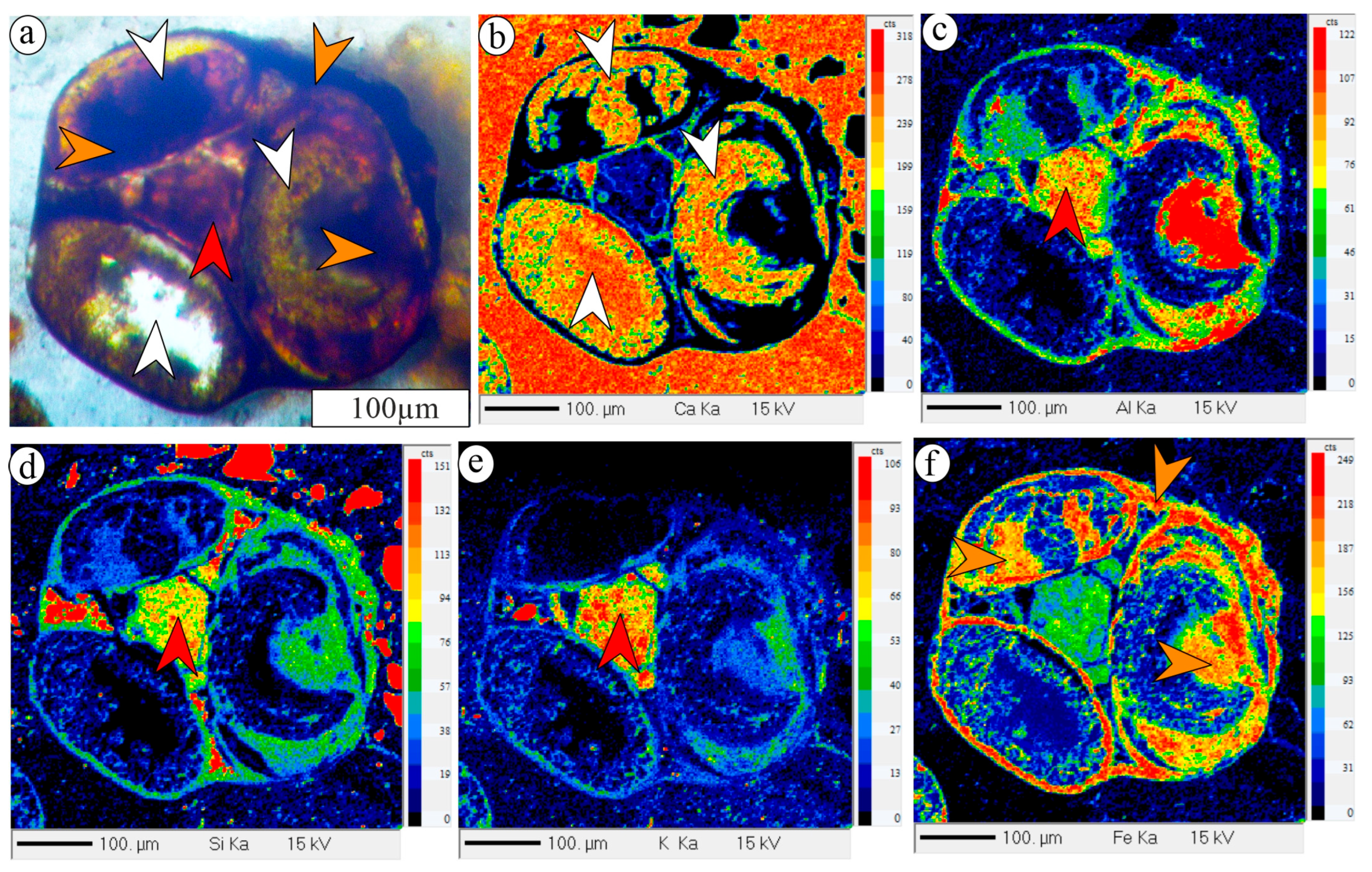

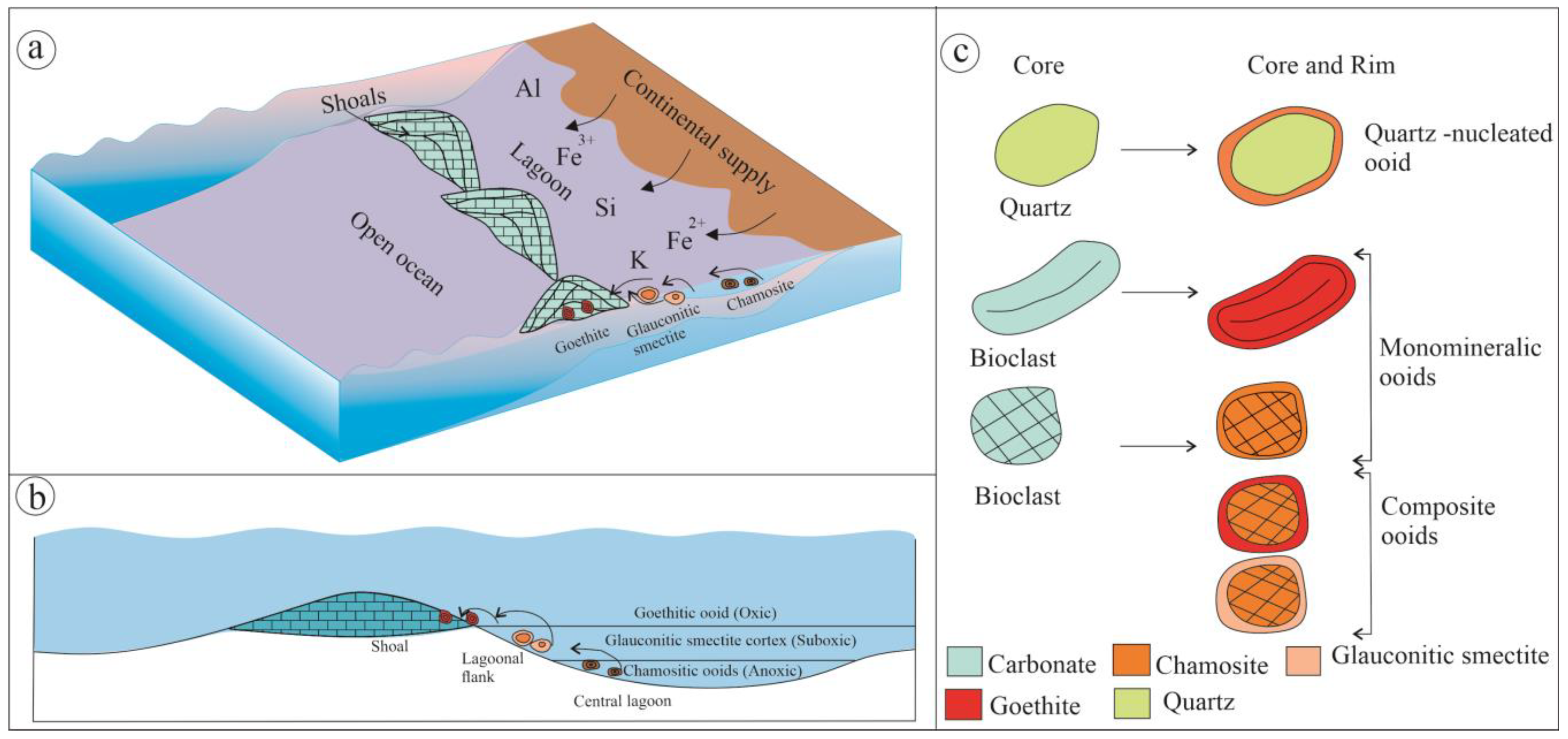
| Sample | Peak Position in Airdried Condition | Peaks Shift After Glycolation | Peaks Shift After Heating at 550 °C | Minerals |
|---|---|---|---|---|
| Randomly oriented powdered whole rock sample of ironstone | 4.9 Å, 4.1 Å, 3.8 Å, 3.3 Å, 3.0 Å, 2.5 Å | - | - | Goethite, Calcite, Quartz |
| Oxfordian Dhosa Oolite (packstone) | 10.6 Å, 5.0 Å, 4.5 Å and 1.5 Å | 10.6 Å peak slightly shifts to 10.0 Å. | 10.0 Å peak slightly shifts to 10.3 Å, and peak intensity increases | Glauconitic smectite |
| 7.2 Å | Peak remains unchanged | Peak remains unchanged | Kaolinite | |
| 4.1 Å, 2.68 Å, 2.5 Å, and 2.4 Å | Peak remains unchanged | 3.6 Å, 2.69 Å, 2.5 Å. | Goethite | |
| Callovian ironstone (grainstone) | 14.6 Å, 7.2 Å, 4.7 Å, 3.4 Å | 14.6 Å peak shifts to 15.0 Å | After heating, the 15 Å splits into two peaks with lower intensity at 13.2 Å and 10.3 Å | Chamosite and montmorillonite |
| 4.2 Å, 3.8 Å, 2.69 Å, and 2.4 Å | Peak remains unchanged | 2.7 Å, 2.5 Å | Goethite (after heating at 550 °C, goethite alters to hematite) | |
| Callovian Golden Oolite (packstone) | 13.3 Å, 9.7 Å, 7.2 Å, and 5.0 Å | Peak remains unchanged | Peak remains unchanged | Glauconitic smectite, Chamosite |
| 4.1 Å, 2.6 Å, 2.5 Å | Peak remains unchanged | 2.7 Å, 2.51 Å, 2.2 Å | Goethite (after heating at 550 °C, goethite alters to hematite) |
Disclaimer/Publisher’s Note: The statements, opinions and data contained in all publications are solely those of the individual author(s) and contributor(s) and not of MDPI and/or the editor(s). MDPI and/or the editor(s) disclaim responsibility for any injury to people or property resulting from any ideas, methods, instructions or products referred to in the content. |
© 2025 by the authors. Licensee MDPI, Basel, Switzerland. This article is an open access article distributed under the terms and conditions of the Creative Commons Attribution (CC BY) license (https://creativecommons.org/licenses/by/4.0/).
Share and Cite
Chakraborty, A.; Banerjee, S.; Bhosale, S.A.; Mandal, S. Callovian-Oxfordian Ironstones at the Northwestern Margin of the Neo-Tethys Ocean, with Mineralogically Diverse Iron Ooids: Example from Kutch Basin, India. Minerals 2025, 15, 990. https://doi.org/10.3390/min15090990
Chakraborty A, Banerjee S, Bhosale SA, Mandal S. Callovian-Oxfordian Ironstones at the Northwestern Margin of the Neo-Tethys Ocean, with Mineralogically Diverse Iron Ooids: Example from Kutch Basin, India. Minerals. 2025; 15(9):990. https://doi.org/10.3390/min15090990
Chicago/Turabian StyleChakraborty, Arpita, Santanu Banerjee, Suraj Arjun Bhosale, and Sabyasachi Mandal. 2025. "Callovian-Oxfordian Ironstones at the Northwestern Margin of the Neo-Tethys Ocean, with Mineralogically Diverse Iron Ooids: Example from Kutch Basin, India" Minerals 15, no. 9: 990. https://doi.org/10.3390/min15090990
APA StyleChakraborty, A., Banerjee, S., Bhosale, S. A., & Mandal, S. (2025). Callovian-Oxfordian Ironstones at the Northwestern Margin of the Neo-Tethys Ocean, with Mineralogically Diverse Iron Ooids: Example from Kutch Basin, India. Minerals, 15(9), 990. https://doi.org/10.3390/min15090990





